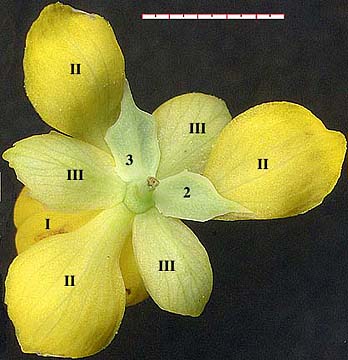

| Key to labels in the images. | |
|---|---|
| 1,2,3 = prophylls | III = outermost sepals |
| II = median sepals | I = innermost sepals |
| B. swaseyi | B. trifoliolata |

|
|
| B. swaseyi | B. trifoliolata, inflorescence bases emerging from bud scales. |
| Click here to open page with additional images | |
| cataphylls | basal prophyll | upper 2 prophylls | epicalyx | sepals | |
|---|---|---|---|---|---|
| Pursh 1814 | 3 x 3 leaves calyx triplex |
||||
| Nuttall 1818 | Calyx 9-leaved, ... in 3 series, exterior bracteiform and small |
||||
| Bonpland et al 1821 | Calyx with 3 bracts tribracteatus | and 6 leaves hexaphyllus |
|||
| Payer 1857 | bud scale écaille de bourgeon | basal bracts of infl. (2) bractée foliacées basal bract of fl. (1) bractée mère | prophylls (2 + 3) bractées secondaires | sepals proper (2 x 3) sépales |
|
| Wooten 1898* | bracts (2) | sepaloid bracts (3) | sepals proper | ||
| Fedde 1901 | bud scales Knospenschuppe | bract Tragblatt | prophylls (2 or absent) Vorblatt | sepals (3 x 3) Kelchblatt |
|
| Ahrendt 1961 | bracts of inflorescence | bract | prophylls (2 or absent) | sepals (3 x 3) | |
| Harms** | bud scales | prophylls (3) | sepals (3 x 3) | ||
| Hitchcock & Cronquist 1973 | bract | bracts (3) | sepals (2 x 3) | ||
| Munz & Keck 1959 | bractlets (3) | sepals (2 x 3) | |||
| Whittemore (FNA) | ? | bracteoles (of infl.) | bracteoles (3) (of flower) | sepals (2 x 3) | |
|
*Wooten describes B. haematocarpa. **In comparing the interpretations of the various authors in this table, I hasten to note that I have examined only two species in detail, both from the Section Horridae, and my views may not be appropriate for other species. |
|||||
Payer 1857 was the first to provide a detailed examination of Berberis floral morphology. And with the exception of Fedde's and Ahrendt's monographs the structure of the Berberis/Mahonia inflorescence has received scant attention in the botanical literature beyond discussion of what to call various floral components, and perhaps this accounts for the lack of a standardized descriptive terminology. Ahrendt 1961 notes (p.16) that
"different authors, or even the same author at different times, have referred to the outer flower components of the same species indiscriminately as bracteoles and outer sepals. Thus ... described, at one time as possessing prophylls and two whorls of sepals, and elsewhere as having no prophylls and three whorls of sepals.
[and for Mahonia]
it is generally possible, after experience in examining the flowers to make a satisfactory distinction. Whereas the prophylls are nearly always 1 or 2 in number, and triangular and acuminate, the small outer sepals in a whorl of 3, are ovate, and acute.
Whetstone et al (FNA) clarify their usage:
The perianth of Berberidaceae is commonly composed of three distinct types of organs, but terminology for the organs varies from author to author. In our treatment, we refer to the small, outer parts as bracteoles (collectively forming a calyculus); the large, middle parts as sepals; and the innermost parts, which are commonly nectariferous, as petals. Some authors have referred to the bracteoles as outer sepals and to the petals as staminodes.Whittemore, as in his FNA description of Berberis swaseyi, follows this usage of bracteole for the perianth, but also as prophyll of the inflorescence:
bracteoles leathery, apex spinose-acuminate, sometimes with proximal bracteoles as described, distal membranous and acuminateAlthough in this later sense it is difficult to discern whether he counts 3 prophylls (bracteoles) or 2. The above description of B. swaseyi is appropriate only if 3, since the upper (distal) 2 prophylls of a spiral series commonly reduce in this manner - and at times even all three in racemes with more than 3 flowers.